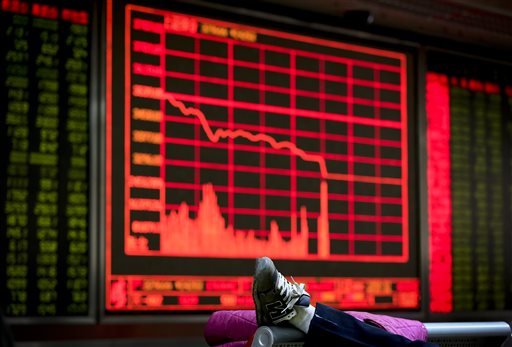
Shanghai’s stock index plunged nearly 7 percent on Monday, sparking a halt in trading of Chinese shares, after weak manufacturing data and Middle East tensions weighed on Asian markets.
The Shanghai Composite Index dived 6.9 percent to 3,296.66 on the first trading day of 2016. The index was at the lowest level in nearly three months.
The official Xinhua News Agency said China halted trading on the Shanghai and Shenzhen stock markets to stop steeper falls. It was the first time China used the “circuit breaker” mechanism it announced late last year.
Authorities have been trying for months to restore confidence in Chinese stocks after a plunge in prices in June rattled global markets and prompted a panicked, multibillion-dollar government intervention. Beijing is gradually unwinding emergency controls that included a freeze on new stock offerings.
Other stock markets in the region also started the new year on a weaker note.
Japan’s Nikkei 225 tumbled 3.1 percent to close at 18,450.98 and Hong Kong’s Hang Seng retreated 2.4 percent to 21,387.07. South Korea’s Kospi closed 2.2 percent lower at 1,918.76.
Stocks in Australia, Taiwan and Southeast Asia were also lower.
Weak manufacturing data was behind the sell-off Monday along with Middle East tensions, which pushed up oil prices.
The Caixin/Markit index of Chinese manufacturing, which is based on a survey of factory purchasing managers, fell to 48.2 in December from 48.6 the previous month, marking contraction for the 10th straight month. It was the latest sign of the headwinds facing China’s economy that add to a downbeat outlook for Asian exporters. On Friday, an official manufacturing index also showed a persistent contraction in factory activity despite Beijing’s stimulus measures.
China’s factory data is “still a long way off stirring up cheer about global demand recovery,” said Mizuho Bank Ltd. in a daily commentary. “Asian exporters are expected to continue struggling with exports contraction and growth prospects dampened by related manufacturing gloom.”
Escalating tensions in the Middle East pushed up the price of oil, analysts said.
Saudi Arabia said Sunday it is severing diplomatic relations with Iran, a development that could potentially threaten oil supply. The world’s largest oil supplier executed a prominent Shiite cleric that prompted protesters to set fire to the Saudi Embassy in Tehran and Iran’s top leader to criticize Saudi Arabia.
“Oil markets will be concerned that this could be an incremental step in a deteriorating political situation that might ultimately threaten world oil supply,” Ric Spooner, chief analyst at CMC Markets, said in a commentary.
Benchmark U.S. crude added 53 cents to $37.55 per barrel in electronic trading on the New York Mercantile Exchange. The contract rose 36 cents to close at $37.04 per barrel on the last trading day of 2015. Brent crude, used to price international oils, rose 40 cents to $37.68 a barrel in London.
In currencies, the dollar weakened to 119.24 yen from 120.26 yen. The euro rose to $1.0883 from $1.0861.
FRANCE 24/(AP)
Leave a Reply
You must be logged in to post a comment.